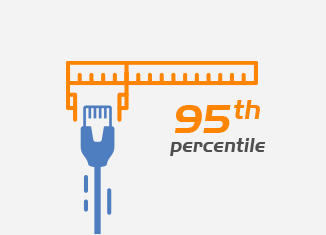 There is a lot of confusion around the 95th percentile bandwidth metering. Therefore this blog posting is intended to provide you with detailed information about the 95th percentile and how it performs versus other bandwidth metering methods.
There is a lot of confusion around the 95th percentile bandwidth metering. Therefore this blog posting is intended to provide you with detailed information about the 95th percentile and how it performs versus other bandwidth metering methods.
What is the 95th percentile, anyway?
The 95th percentile is a method of metering bandwidth usage that allows clients to slightly burst over their committed rate, giving the carrier an ability to scale their billing with the cost of the infrastructure and transit commits. It’s an alternative to either fixed or actual data transferred payment methods, which are commonly seen outside the Data Center where erratic bursting is either forbidden or fined with greater bills. The 95th percentile allows a client to experience a small burst in traffic with no overage charges. This method states that in 95% of the time, the usage is around or below the specified amount. On the other hand, 5% of the time, the usage can be bursting beyond this rate. One significant factor of misunderstandings is the resemblance of the 95th percentile to the average bandwidth usage. The 95th percentile is not a mean. The 95th percentile represents the value that your bandwidth is at or under 95% of the time.
The report is straightforward. Every 5 minutes, your circuit is sampled for the total amount of bytes transferred. This data amount is averaged over 300 seconds to estimate the average transfer rate for the mentioned time period per second. These averages are collected every 5 minutes and are stored in a database. When the month is over, the data is arranged from high to low with the top 5 % of data points being ignored. The subsequent highest data showing after that becomes the 95th percentile average. Thus, the fastest 5% of your traffic or the speediest 36 hours of the month are annulled.
CIR – Committed Information Rate
CIR or Committed Information Rate is a billing method that guarantees that, even though your company shares a bandwidth pool with a number of other users, you will obtain, at least a share of it, regardless of how busy the link gets. So, depending on whatever speed you choose, you get it on a constant basis regardless of how many users are subscribed to the carrier. Your connection becomes independent; nevertheless, you will most definitely have to pay for that benefit.
95th percentile advantages over CIR
With the 95th, businesses can pay for what they utilize (to a certain extent) instead of having a bandwidth cap employed. It is very important with the CIR model to accurately calculate how much bandwidth the business will use as it will not be able to go beyond this rate without upgrading the company’s connection speed, which is not the case with the 95th percentile’s flexibility. There is no need for carriers to set caps and apply various policies to maintain the traffic below the customer’s commit rate. Therefore, the 95th percentile metering reduces the provider’s infrastructure and management spending.
Actual Usage
The Actual Usage method is calculated by metering the actual throughput. It is somewhat similar to 95th percentile method. Though, instead of measuring the rate, the provider records the amount of data moved over the circuit for the specified time interval.
95th percentile advantages over Actual Usage
When compared to the Actual Usage metering, the 95th percentile appears to be far less volatile. The businesses get the assured minimum bandwidth commits that allow them to better scale upstream capabilities. Bursty clients are charged way more than the sustained ones for a similar amount of data when applying the Actual Usage billing method, considering that the effect of bursty traffic is larger and is more problematic to prepare for.
The 95th percentile aims to find a middle ground between scalability, volatility, and cost for the carrier and the customer, coping with that task quite well. However, no method is perfect. The 95th percentile is more volatile than the Committed Information Rate on predominantly bursty months and the monthly statements can differ dramatically. 95th percentile can make you pay for a big amount of idle bandwidth.
Multi-homed Service Providers and Enterprises face the challenge of keeping their traffic usage below the level committed with each of their ISPs. Starting with Noction Flow Analyzer v 21.06, percentile value calculation, be it for 95th or any other, is available for packets, octets, and flows. Noction IRP Commit Control feature, in its turn, addresses the issue by incorporating billing structures into its policy models. It enables keeping the commit level at a preconfigured value.
Nowadays the 95th percentile is one of the most common billing methods used by ISPs. Products like NFA and IRP help Service Providers avoid unnecessary spending that occurs every time their traffic attempts to go over the 95th percentile.










